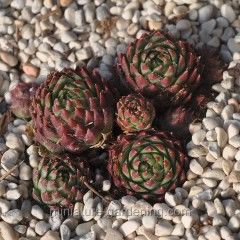Cluck! Taking a Look at Hens and Chicks
 When you see the phrase “hens and chicks,” do you think of plump birds pecking around the barnyard? You might be right, but in the miniature gardening world, those words have an entirely different meaning. “Hens and chicks” is the common name for a group of succulent plants. The plants in the group have varying colors, textures, and forms, but they share two things. Almost all have a rosette shape. And hens and chicks plants also propagate regularly, producing numerous “babies” from the “mother” plant.
When you see the phrase “hens and chicks,” do you think of plump birds pecking around the barnyard? You might be right, but in the miniature gardening world, those words have an entirely different meaning. “Hens and chicks” is the common name for a group of succulent plants. The plants in the group have varying colors, textures, and forms, but they share two things. Almost all have a rosette shape. And hens and chicks plants also propagate regularly, producing numerous “babies” from the “mother” plant.
After a year or more, you may notice that the mother plant flowers dramatically. After flowering, the mother rosette dies, leaving room for the new chicks to spread out and produce more chicks. The mother can be gently removed to prevent overcrowding. Flowering can sometimes be a sign of poor conditions. Drainage and light should both be checked after a plant flowers.
These low-growing perennials can be mat-forming, spreading via underground roots. They spread relatively quickly when planted outdoors as ground cover plants, typically producing several chicks per growing season. Chicks can be broken off and transplanted. Typically, gardeners will choose them for fairy gardens or rock gardens, as they are drought-tolerant and prefer sharp drainage. They are often grown in cracks, such as in-between garden stepping stones or tucked beside a fairy cottage. Native to Europe, these plants were once grown on thatched rooftops. They helped prevent lightning fires. Today, they are prized for their impressive looks. Hens and chicks come in a diverse array of colors and shapes.
Sempervivum arachnoideum is also known as “tiniest of tiny.” This variety is incredibly small, which makes it ideal for a fairy garden, miniature garden, or desktop terrarium, as long as your desk receives plenty of dry heat. Sempervivum Chick Charms, Gold Nugget has large, fleshy leaves and sports attractive gold and red coloring. If you are looking for something unusual, you might consider Sempervivum tectorum, Oddity, with its holly, upright, pointed "pipes." Whether your miniature garden is fantastical, ornate, or minimalist, you are bound to find a hens and chicks variety that suits you. If you have specific color needs, hen and chicks can provide rich colors, from deep purple to bright copper. Colors are known to change as the weather warms or cools.
When you are considering hens and chicks for your next fairy garden project, trough garden, or xeriscape garden, you will want to make sure you have all of the “musts” for this succulent. While hens and chicks are not particularly hard to grow, there are a few things they need. Though they can be grown successfully indoors or out, as desert plants, they must be provided with full, hot sun. They also need gritty, sandy, well-drained soil. Gravel or hard, mounded clay both work well. If your soil is heavy, you can mix in some peat. Aim for a neutral soil pH.
Take care not to overwater hens and chicks. These plants are drought-tolerant and do not need to be watered often. Check to see if the soil is dry before watering.
Ready to add hens and chicks to your fairy garden, miniature garden, or rock garden? Find a variety (or two, three, or four different varieties!) that is right for you and your space. Plant the “hen” and get ready to watch your new plant flourish with relatively little care. Just remember, these are not the types of hens and chicks that say “Cluck!”
Comments
{{ errors.first("comment") }}


